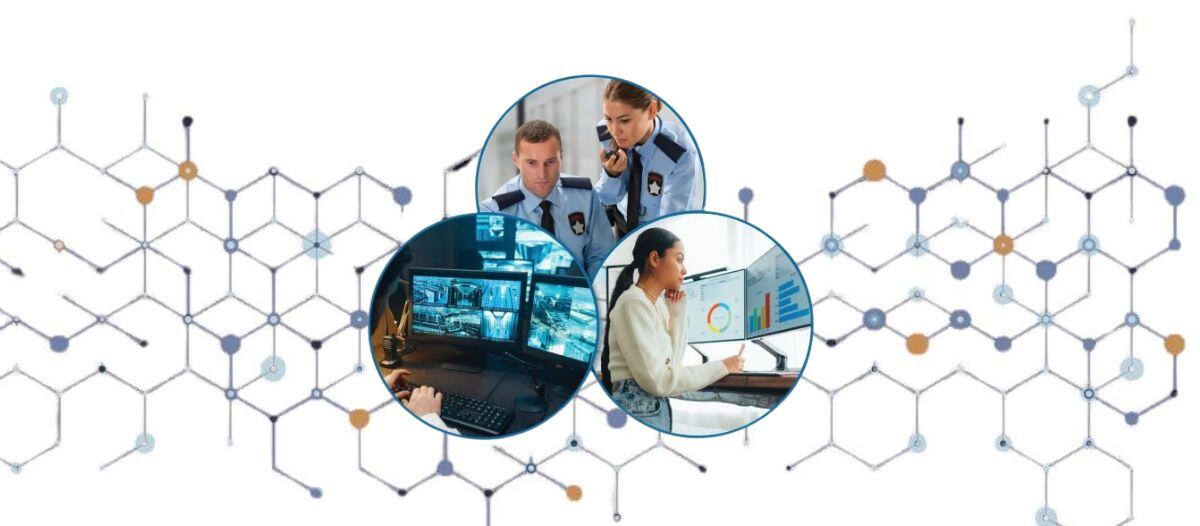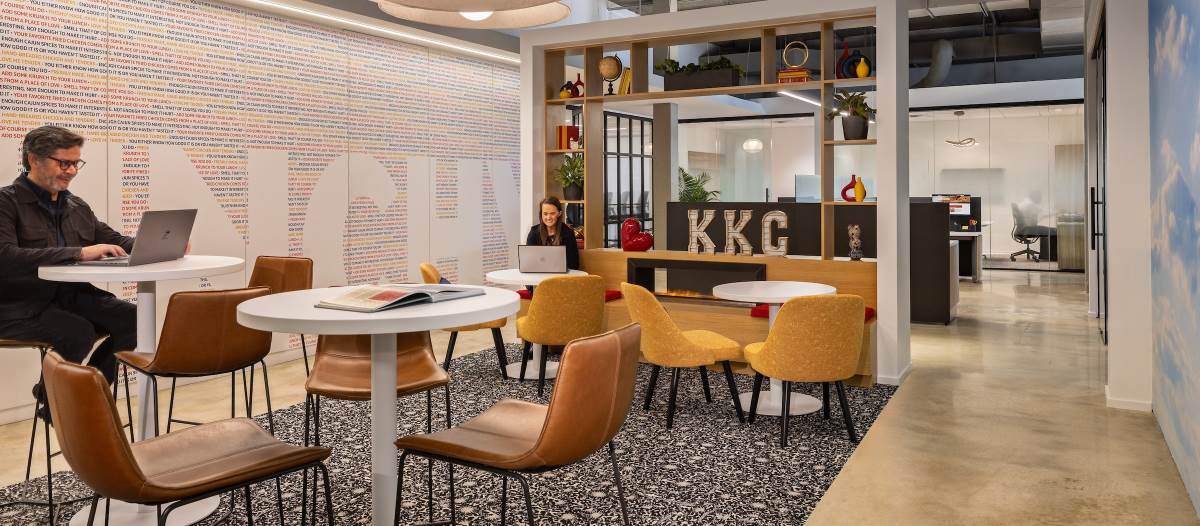A Safety Trifecta
Security, technology & the hybrid workplace

When people feel safe, they are more productive – at work, at home, in life. Numerous studies support this fact, but on a human level, people understand this. As news headlines prove how the world can feel less safe, companies are navigating a new work landscape where office populations ebb and flow, varying not only from business-to-business and building-to-building but from day-to-day, floor-to-floor and person-to-person.
A positive development is that businesses are more aware and accommodating of their employees’ needs. Offices are designed with more amendable space types, from collaborative spaces to quiet zones. Employers understand the importance of people feeling secure, and how that sense of security affects employees’ well-being — 77 percent of people affirm that mental health is “extremely important” in the workplace, according to Alert Media’s report, The State of Employee Safety in 2023, and are responsive.
The challenge for facility management professionals is adopting strategies that ensure a safe workplace experience in this hybrid environment. It may make sense that people who split time between working in an office and remotely feel safer at home — 89 percent feel “extremely safe” in their home environment as opposed to 60 percent in the office, according to Alert Media. But with today’s increasingly popular hybrid work model, facility professionals can aim to move the needle in a positive direction to amplify a sense of safety at work with tried-and-true security principles to amplify the employee experience.
Make hospitality the front line of security
A security professional is often the first face that employees see as they come to work and the last person they see when they leave, whether at an entrance gate or reception desk or on patrol in a parking lot.
Understand the power and importance of making sure physical security officers are visible and approachable. Presence is a powerful assurance and deterrent. When someone walks into a bank, it is almost certain that person will be acknowledged and greeted by security staff or an employee. For the regular bank client, this provides an inviting atmosphere; but for someone with bad intentions, there is a more subliminal message: I see you.
Security is about omnipresence. Officer training should include hospitality principles, so they reinforce a welcoming atmosphere while sending a strong, reassuring message: I’m here for you.
The larger the security presence, which means more eyes and ears on watch, the more effective the security operations will be. That is not to say they will need more people to run it.
Use technology to make security smarter
When applied correctly, technology helps people see and accomplish more.
However, cost and labor challenges have led to questions like, “Can we replace an officer with a technology solution?”
There is not a perfect answer to that question, but more importantly, the question should be reframed. Instead of thinking of the dynamic as people versus technology, think of it as people plus technology. It is ideal to hire, train and retain a smart officer who knows the building, security policies, emergency procedures and culture. By ensuring technology tools are leveraged and at their disposal, FM professionals can make the security staff more effective.
There are limitations to technology. An officer’s intuition cannot be replaced. There is something to be said for looking someone in the eye and making a personal connection.
Likewise, there are instances where technology applications can do things that people cannot. Video cameras with analytics can identify and analyze things that the naked eye cannot see. The cameras can cover more ground at once than a person could on foot. This allows people to focus on more critical tasks and respond more effectively at a distance when there is a potential threat – minimizing risk while increasing safety for security officers.
When security teams are empowered with strategically placed cameras inside and out, and integrate access control and alarm systems, a single officer’s effectiveness can exponentially be increased.
Here are some ways to utilize technology for efficiency and safety:
- Share patrol and monitoring duties with a remote security operations center. One location can help oversee multiple sites and dispatch resources as needed.
- Analyze threats before officers engage using smart cameras. They can provide alerts if something is out of the ordinary, such as a vehicle approaching at 3 a.m., a human trespassing in a space or someone loitering in a parking lot.
- Deter an incident with an audio announcement through a camera system. This keeps an officer out of harm’s way as much as possible.
- Strengthen building access control and visitor management systems individualized through each employee’s mobile device.
Do not adopt technology for its own sake. Many organizations make the mistake of buying technology before their security needs are fully understood. Ensure the security team understands what problems they need to address before investing and how to maximize the technology’s features to ensure there is a strong return on the investment.
Build Relationships with Business Neighbors and Local Law Enforcement
Security awareness should begin far from the front door; it starts down the street. If there is an awareness of the threats a neighbor is facing, then the security team can be better prepared if trouble makes its way to a facility.
The NBA’s Dallas Mavericks owner Mark Cuban emphasized this in 2017 during ASIS International’s GSX, the world’s largest annual gathering of security professionals. He noted thousands of people converge on the American Airlines Center for basketball games, concerts and other events, and ensuring their safety is paramount to the guest experience. Cuban said his security team does not consider their security perimeter as being confined within the walls of the stadium or the sidewalks around it. The security perimeter is multilayered, extending to the bars and restaurants in the surrounding district.
By partnering with the community, sharing intel with business owners and other nearby stakeholders, Cuban found officers were more prepared for potential threats. Whether it is across the street or down the block, if something suspicious or dangerous is taking place, they have a lead on it. Security teams must be aware of what is happening around them and connect with security directors of nearby sites.
Technology makes this easier than ever – information can be shared at the click of a finger through emergency notification systems, situational awareness tools, community association portals or by using messaging apps or text.
Reach out to local law enforcement and build bridges with them. During an emergency is not the time to exchange business cards.
Many police departments have business liaisons who are more than willing to connect with on-site security teams and share resources. Site visits, walk-throughs and tabletop exercises with the police, SWAT and/or fire department are great ways for familiarization and to identify action items to enhance operations.
Build a proactive security culture
 Circling back to the idea that more eyes and ears make security operations more effective, consider the multiplier effect of everyone in a building seeing security as their responsibility.
Circling back to the idea that more eyes and ears make security operations more effective, consider the multiplier effect of everyone in a building seeing security as their responsibility.
Now, in addition to security officers, cameras, friends across the street and the police officer who routinely drives or stops by – eyes and ears everywhere.
Security teams and other facility service providers should not work in silos. As custodians, landscapers and engineers move about the building, they should know their security partners and how to report anything suspicious they observe. Encourage them to trust their gut. This goes back to building strong relationships and a culture of trust, including within internal teams. Cyber and physical security teams also need to work together to identify vulnerabilities, create protocols and be aware of ways they can support one another.
It is also important to be proactive about security awareness. Inform and engage with the community.
Alert Media found that the best way to make employees feel like safety is a business priority is to improve communication about safety, and the best way to help them feel more prepared to navigate a crisis is by conducting more safety training and emergency drills. Public town halls for the buildings’ employees can also connect them with vital resources like security training, public transportation tracking apps, emergency alerts and easy ways to report incidents. These events also build that visibility and trust for the security program and the entire staff.
Here are some ways to build up and reinforce a proactive and holistic security culture:
- Meet with department heads, key staff and essential personnel to share best practices, host training for their teams and listen, hear and respond to their concerns.
- Ensure everyone knows how to report an incident or suspicious activity. See something, say something, do something!
- Utilize company employee engagement apps, the intranet and digital signage to relay key information.
- Share daily reports so the appropriate stakeholders are aware of what is taking place around the building, including events.
- Recognize and celebrate positive behavior (including when officers receive praise).
- Inform guests of security best practices with a handout or through the visitor management app before and when they arrive.
- Host huddles before events, bringing the service parties together and introducing them to the person responsible for security.
There is no foolproof way to prevent every single threat, but by expanding the power of security officers with integrated technology, supporting them with a strong community, and driving a proactive culture, teams can be better prepared to mitigate risk and respond to threats. The workplace of tomorrow will look different than today’s hybrid landscape. The tools will change, but these principles will surely apply.

Russ Collett is ESFM’s vice president of security solutions and has more than three decades of security experience, including 25 years with the U.S. Secret Service as a special agent. Here he planned successful security for seven U.S. presidents and visiting world leaders. He serves on the board of directors of the Illinois Security Professionals Association, is an active member of ASIS International and the U.S. Secret Service Association. Collett was twice named to Security Magazine’s Security 500 Rankings.
Read more on Occupancy & Human Factors , Risk Management and Workplace
Explore All FMJ Topics









